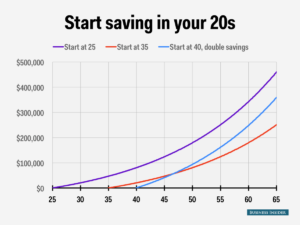When you think about investing in the long term, don’t just stock up on bulk stacks of printer paper and buy out all the coconut water at Costco.
While it’s important to plan for things like your future needs and time savings (hey, that printer paper is gonna last a while), few things are more important than ensuring long-lasting and dependable financial resources to support you late into life.
Instill the importance of long-term investing to your employees by helping answer their questions about 401(k) retirement plans.
Right now, they’re likely groaning at the thought of setting one up, deciding how much to put aside, transferring their account over if they need to change companies, and so on. It’s a world chock-full of jargon, and we’re here to break it all down for you.
1. What is a 401(k) plan, and why is it called that?
A 401(k) is a retirement plan: cash taken out of your current that will replace employment income when you’re ready to enter the next stage of your adulting career.
If you elect to contribute to your plan, the percent you choose will be automatically deducted from your paycheck each pay period. This money is taken out before your paycheck is taxed (so more of it can go to your retirement instead of the government). The contributions are invested at your discretion into one or more funds provided in the plan. While the investments grow in your 401(k) account, you still don’t pay any taxes on it. Nice!
Oh yeah, and it’s named for the section of the tax code that governs it (we know, so clever).
2. What’s my company’s role in my 401(k)?
You’ll often hear about employer-sponsored plans, which is when your company takes responsibility for establishing and maintaining employees’ 401(k) plans. Employers often “match” employee contributions, meaning they’ll agree to contribute a set percent of money to your plan if you also contribute a certain percent.
Say your company has a 50 percent match policy, and you decide to contribute six percent of your annual salary to your 401(k). Your company would then contribute three percent, and your total contributions for the year would be nine percent of your annual salary.
You should always maximize your employer’s match — it’s basically free money, and it’s also safe from taxation while it’s sitting in a 401(k) account.
3. Do all companies match 401(k) contributions?
Though it’s common practice at larger companies, employers are not required to match contributions.
A company has complete control over whether or not they do, since the match is a form of profit sharing. If your employer is not highly profitable or going through a tight financial situation, they may opt not to match the contributions.
Whether or not your company offers a match, though, shouldn’t deter you from regularly adding money to your own 401(k).
4. Are all 401(k) plans created equal?
Not quite. Having these qualities can make a plan more advantageous than others:
- Ability to participate right away: Many companies require one to three months (or even up to a year!) of employment before workers qualify to join the retirement plan. The sooner you can participate and start taking advantage of any employer match, the better.
- A generous 401(k) match: Meaning the more you contribute, the more your employer will, too. That’s just more money in your (retirement) pocket.
- Immediate vesting: You won’t get to keep your employer’s contributions to your 401(k) account until you are vested in the plan — and some companies require more time in service before you can keep the entire match provided.
- Low expenses or the plan sponsor pays most fees: There are fees associated with establishing and maintaining 401(k) accounts. It’s great if you can hook up with an employer who is generous enough to cover (fully, or a good margin of) these fees.
- Automation: Automatic enrollment, deductions, and filing will make your life so much easier. Need we say more?
5. When do I need to start contributing?
The most important thing to know about 401(k)s is that the earlier you start working on one, the better. The more money you save now, the more your money will have grown by the time you need to use it, and the bigger the nest egg you’ll have to cuddle with when you go home at night.
Source: Business Insider
6. How much should I contribute, and how often?
A generally accepted amount is 10 percent each pay period, however, you should invest as much as you feel you can afford if you want to maximize your retirement planning successfully.
That being said, take into consideration other funds that require your financial attention: make sure you have enough in emergency funds and shorter-term savings, so that you don’t have to borrow or use any of your 401(k) money before you retire (see question 9). At the least, attempt to contribute as much as your employer matches, since that is a guaranteed return on the match, whether it’s 50 or 100 percent.
Keep in mind that throughout the year, you have the option to adjust your contributions per pay period. So if you find yourself needing to play catch-up, you might decide to contribute up to 25 percent (depending on your salary—see the next question) for four months. Then, you can reduce your contribution to the minimum your employer match requires, depending on your financial situation.
7. What’s the maximum I can contribute?
There are annual limits to how much you can add to your 401(k).
- In 2018, if you are under 50 years old, you can contribute a maximum of $18,500.
- If you’re 50 or older, you can make an additional catch-up contribution of as much as $6,000, for a total of up to $24,500.
Those limits change annually to track inflation.
8. What should I do with an old 401(k)?
You have a couple of options to weigh when leaving a company you’ve established a 401(k) with:
- Leave assets in your previous employer’s plan
- Move the assets into a rollover IRA or a Roth IRA
- Roll over the assets to a new employer’s workplace savings plan, if allowed
- Cash out or withdraw the funds
What you choose will depend on your current financial situation and your goals for your retirement plan. Be sure to evaluate the pros and cons of each option.
9. How long do I need to wait before I can use my money?
Typically, you can’t withdraw any of your retirement money before age 59½ (so specific!) without incurring a 10 percent early withdrawal penalty from the IRS. This early distribution penalty is the cornerstone of the government’s campaign to discourage us from ravaging our savings before our golden years.
There are only two ways to dodge the penalty if you need to withdraw before you reach the age of 59½: If you’re at least 55 or do something called a Section 72(t) distribution.
If you’re retiring from the company that’s currently sponsoring your plan and are at least 55 years old, you can begin to withdraw monthly income from your 401(k) with no penalty. However, you will owe income tax on the amount (your company’s benefits administrator can give you details on this).
Whatever your age, your employer is required to give you a “Summary Plan Description” annually and upon request, which will address early retirement options in your 401(k) plan. If you rollover your 401(k) into an IRA, this option is not available to you.
The one other way around the 10 percent withdrawal penalty is through the “substantially equal periodic payment exception,” also known as a Section 72(t) distribution. This option generally gives you the least retirement pay-out available, and can be used by anyone with a 401(k) plan, regardless of age.
In a 72(t) withdrawal, the distributions must be “substantially equal” payments based upon your life expectancy. Once the distributions begin, they must continue for a period of five years or until you reach age 59½, whichever is longest.
You can read more about it here on the IRS website.
10. How many plans can I have?
There’s no legal limit to the number of 401(k)s you can have at one time, but you can only contribute new money to the plan at your current employer. Therefore, it usually doesn’t make sense to keep open 401(k) plans from previous companies. To simplify things, better monitor your investments, and maintain control over your accounts, it’s a good idea to consolidate old 401(k)s into your current 401(k) or an IRA.
Hopefully you’re now thinking about 401(k)s more as 401(yay)s. And with this overview, you’ll be able to understand what they are and what they can do for your employees.
This article originally appeared on Gusto.com.


